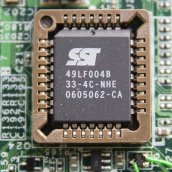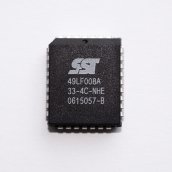Flashing LinuxBIOS on A-Test Boards
Contents
Warnings
YOU CAN BRICK YOUR MACHINE IF YOU FOLLOW ANY OF THESE STEPS!
DO NOT FOLLOW THESE STEPS UNLESS YOU ARE SURE YOU KNOW WHAT YOU ARE DOING!
Hardware
These instructions are only for the revision "A" test boards. You can place a PLCC EEPROM into the (only) socket on the test board, flash it with LinuxBIOS, and reboot from the EEPROM chip containing your newly flashed LinuxBIOS.
For now, this only covers writing the image to this PLCC ROM chip and using it in that PLCC socket; there is no sane way to write to the serial flash (that which contains the normal BIOS) without a huge risk of bricking your device.
You will want to use 8-Mbit EEPROM chips.
Boot with normal BIOS and setup toolchain
Use your normal serial BIOS (currently, by Insyde Software) to boot into a Linux distribution. You'll need to build some software before you can flash your EEPROM chip with LinuxBIOS.
rdmsr
Build the rdmsr (read MSR) tool by Ron Minnich:
#include <sys/types.h>
#include <sys/stat.h>
#include <fcntl.h>
#include <unistd.h>
#include <stdio.h>
#include <stdlib.h>
int main (int argc, char *argv[])
{
unsigned char buf[8];
int fd_msr, i;
unsigned long addr = 0;
if (argc < 2) {
printf("usage:rdmsr reg\n");
exit(1);
}
addr = strtoul(argv[1], NULL, 0);
fd_msr = open("/dev/cpu/0/msr", O_RDONLY);
lseek(fd_msr, addr, SEEK_SET);
read(fd_msr, buf, 8);
printf("MSR register 0x%lx => ", addr);
for (i = 7; i > 0; i--)
printf("%2.2x:", buf[i]);
printf("%2.2x\n", buf[i]);
return(0);
}
with:
% gcc rdmsr.c -o rdmsr
wrmsr
Build the wrmsr (write MSR) tool (also by Ron Minnich):
#include <sys/types.h>
#include <sys/stat.h>
#include <fcntl.h>
#include <unistd.h>
#include <stdio.h>
#include <stdlib.h>
int main (int argc, char *argv[])
{
unsigned char buf[8], *p;
int fd_msr, i;
unsigned long addr = 0;
if (argc < 3) {
printf("usage:wrmsr reg value\n");
exit(1);
}
addr = strtoul(argv[1], NULL, 0);
p = argv[2];
printf("MSR register 0x%lx => ", addr);
for (i = 7; i > 0; i--) {
buf[i] = strtol(p, &p, 16);
p++;
printf("%2.2x:", buf[i]);
}
buf[i] = strtol(p, &p, 16);
printf("%2.2x\n", buf[i]);
fd_msr = open("/dev/cpu/0/msr", O_WRONLY);
lseek(fd_msr, addr, SEEK_SET);
if (write(fd_msr, buf, 8) < 0)
perror("");
return(0);
}
with:
% gcc wrmsr.c -o wrmsr
flashrom
Download the latest LinuxBIOS snapshot to get the flashrom utility. Unpack the archive, and go into the util/flashrom directory. After making sure you have your distribution's pciutils and pcituils-dev package installed, run make. This will build the flashrom utility; copy it into a convenient location (such as /usr/local/bin).
Flashing
Inserting the chip
Because the board will be booting from the EEPROM chip we insert, we cannot boot while a blank EEPROM chip is inserted (otherwise you will not be able to boot). Thus, you're going to have to insert the EEPROM chip while the machine is running.
Be quick and careful: and remember, pin 1 is the triangle/dot, and these must line up with the socket properly. See the pictures at the right for guidance.
If you're using an A test board and a PLCC EEPROM chip, go ahead and insert the chip now, before following the next few steps.
Enable writing to flash
On Linux, make sure you have the MSR module loaded:
% modprobe msr
so you will have MSR device files. To enable PLCC writing on the OLPC board, you need to enable flash writing. Once you've built rdmsr and wrmsr, run:
./rdmsr 0x1808
./wrmsr 0x1808 22:ff:80:02:10:f7:bf:00
./rdmsr 0x1808
Using flashrom
Once you've got flashrom working, you can now flash your LinuxBIOS image. Check that flashrom can see your writable flash chip:
% flashrom -V
You should see a note about a writable part being detected. If so, you can now write to the part, with the LinuxBIOS image you've built previously:
% flashrom -w linuxbios.rom
Once it's written, verify that it has been written properly:
% flashrom -v linuxbios.rom
Boot with LinuxBIOS
You can now reboot. Make sure you shutdown properly (your disk/filesystems must be in a consistent state, and been unmounted properly). On reboot you'll be greeted by the OLPC LinuxBIOS splash screen, where you can select boot method. Choose USB to boot from a USB disk, hopefully using one of the build images.
- Newer versions of the rom (after Aug 10) will boot from NAND/USB without keyboard intervention. Press ESC during the progress bar to see the boot menu.--JordanCrouse (Talk to me!) 15:12, 11 August 2006 (EDT)

